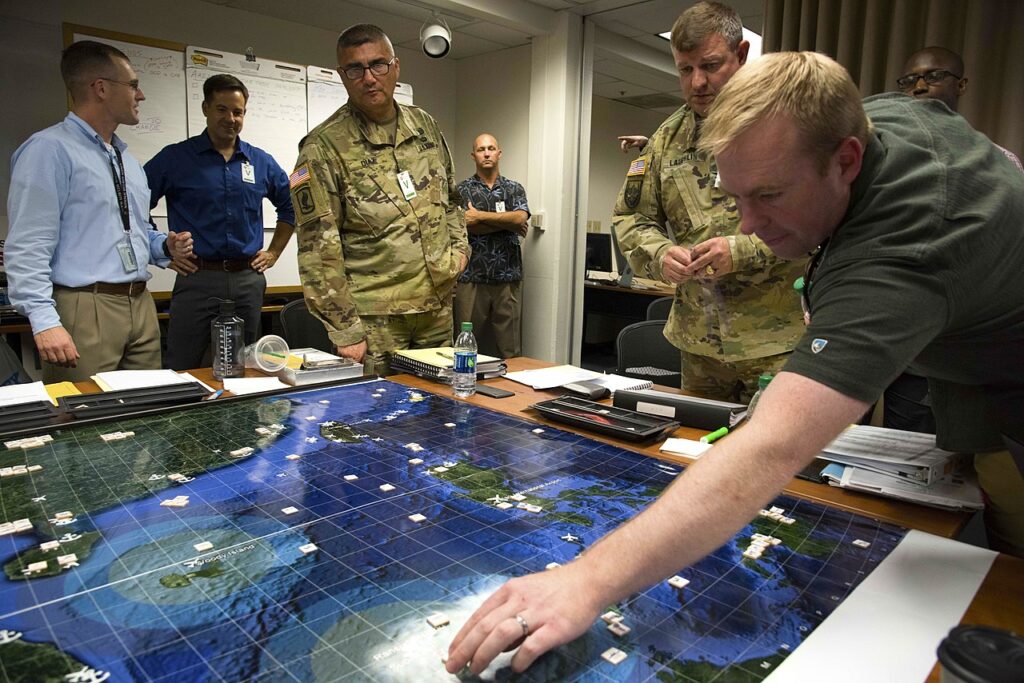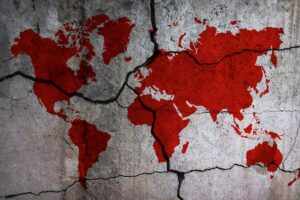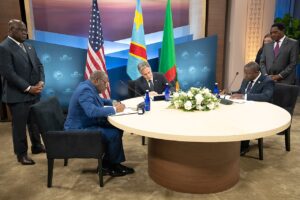The Red cell project
The Red Cell was a small unit created by the CIA after 9/11 to ensure the analytic failure of missing the attacks would never be repeated. It produced short briefs intended to spur out-of-the-box thinking on flawed assumptions and misperceptions about the world, encouraging alternative policy thinking. At another pivotal time of increasing uncertainty, this project is intended as an open-source version, using a similar format to question outmoded mental maps and “strategic empathy” to discern the motives and constraints of other global actors, enhancing the possibility of more effective strategies.
The conventional wisdom in Washington is that China is preparing for an imminent war with the United States in an effort to reunify with Taiwan by force. Chinese President Xi Jinping has instructed the People’s Liberation Army (PLA) to be ready for war by 2027, though CIA Director William Burns has said that such military planning does not mean that China will launch a war by then. Burns added that China may harbor doubts about whether it has the capability to execute the largest amphibious assault since D-Day in World War II. Nevertheless, during the past year, several top U.S. military officials have assessed that China will invade Taiwan by 2025 or by 2027.
According to Xi’s speeches and Chinese Communist Party (CCP) documents, Beijing sees unification with Taiwan as necessary to fulfill Xi’s “China Dream”: the “great rejuvenation of the Chinese nation.” The CCP seeks to achieve this goal by 2049, the 100th anniversary of the People’s Republic of China’s founding. Thus, the CCP views Taiwan as an existential issue, much as Russian President Vladimir Putin views Ukraine: If Beijing launched a war over Taiwan, it could not afford to lose.
As cross-Strait tensions have escalated, there is troubling mutual demonization on the part of both the United States and China. Hypernationalism is also at work in both countries, which is superseding an awareness of the immense risks of a conflict between two nuclear powers. This is in contrast to the 1962 Cuban Missile Crisis when the diplomacy of both U.S. and Soviet leaders was animated by a terror of starting a nuclear war, which was narrowly averted. Over 60 years later, would – or could – either China or the United States “win” a war over Taiwan? And could it be called a victory in the event of a nuclear exchange?
Death and Destruction
Various war games during the past decade — including one played by the House Select Committee on the CCP last April and others by the Department of Defense (DOD) — have yielded similar results. In these hypothetical scenarios, a Chinese amphibious and air assault is triggered by Taiwanese moves toward unilaterally declaring independence. The United States, having failed to deter such an attack, responds with force, and sometimes with allies. The result is massive deaths and casualties in the thousands, and swift escalation of the conflict — not to mention the destabilization of the global economy. A war game conducted by the Center for Strategic and International Studies, a Washington think tank, ran scenarios 24 times. These produced, at best, pyrrhic victories for the United States:
“In most scenarios, the United States/Taiwan/Japan defeated a conventional amphibious invasion by China and maintained an autonomous Taiwan. However, this defense came at a high cost. The United States and its allies lost dozens of ships, hundreds of aircraft, and tens of thousands of service members. Taiwan saw its economy devastated. Further, the high losses damaged the U.S. global position for many years. China also lost heavily, and failure to occupy Taiwan might destabilize Chinese Communist Party rule.”
Though the full results were not made public, a recent tabletop simulation organized by a think tank for the House Select Committee on the CCP had a similar outcome. According to one participant, the shocked members of Congress were “. . . confronted with the potential for death and destruction on scales that haven’t been seen in decades . . . ” In most such simulations, China, with a roughly 1,900-to-300-plane advantage over Taiwan, launches air and missile attacks that destroy Taiwan’s air capabilities, conducts cyber attacks to cripple communications and critical infrastructure, and imposes air and naval blockades.
The “tyranny of distance” for the United States gives proximate Beijing an initial edge. War simulations, such as that of the Center for New American Security, project that a war over Taiwan would rapidly escalate, with China bombing U.S. bases in Japan and Guam, the U.S. hitting Chinese bases and naval forces, and Beijing conducting a demonstration nuclear strike off Hawaii. In short, the losses on both sides are daunting, and the potential for even wider escalation exists at the games’ termination.
China’s Best Strategy?
In light of the probable grave risks to China’s military, economy, and the legitimacy of the CCP, the assumption that a full-scale U.S.–China war over Taiwan is Beijing’s best strategy to achieve reunification, as argued in Elbridge Colby’s influential book, The Strategy of Denial, might be wrong. Even with Beijing’s rapid modernization, China has only a fraction of the amphibious lift capability (including civilian ships) that was deployed in the D-Day assault on Normandy during World War II. Transporting 150,000 or more troops and sustaining logistical support would be problematic. In the recent simulations, China succeeds in occupying positions in the north of the island, but Chinese forces get bogged down with fierce Taiwan resistance, resulting in a grinding ground battle. In short, the assumption that China’s best option is to launch a military assault, despite such obvious limitations and risks, reflects a projection of the well-worn U.S. approach to geopolitical problem-solving: Because I have a large hammer, every problem looks like a nail.
Instead, such a conflict — which is certainly possible and for which the PLA and the Pentagon are indeed preparing — could be viewed by Beijing as China’s worst-case option for resolving the Taiwan question.
After all, and as the Taiwanese are well aware, Beijing has a spectrum of non-kinetic means to coerce Taiwan into reunifying with China. In many respects, the current situation is a continuation of a near-century-old Chinese civil war in which Beijing employs diplomatic, economic, and military pressure in the “gray zone” (actions between war and peace).
Military and cyber intrusions have intensified during the past few years, particularly after the August 2022 visit to Taipei of then-House Speaker Nancy Pelosi. Some in China perceived that the United States was moving away from the One-China policy, which has been the foundation of US-China relations for over 50 years. Among other gestures to more tightly embrace Taipei, President Joe Biden has said four times that U.S. troops will defend Taiwan if attacked — though he later walked back from that assertion. A group in Congress has proposed a resolution to recognize Taiwan as an independent country.
Beijing, arguing that its actions are in response to a perceived policy shift to “One-China, One-Taiwan”, has in effect, created a new normal with persistent overflights around Taiwan, including many times over the median line (the sea border between China and Taiwan) and inside Taiwan’s Air Identification Zone. This escalation was dramatized in Beijing’s response to the Pelosi visit with massive air and naval exercises involving 200 planes and 50 ships, as well as missile firings — in effect, simulating an air and naval blockade. Beijing also used economic coercion, blocking Taiwanese exports of pineapples and other goods.
In the interim, China has continued to step up its gray-zone efforts to intimidate and wear down Taiwan. In 2022, China sent 727 planes in and around Taiwan’s airspace — a 79% increase from the previous year. So far in 2023, the number has increased to 850 planes. Beijing also conducts cyberattacks on Taiwan —more than 2 million times a month—along with malicious emails and disinformation flooding Taiwan. In short, the available evidence does not suggest that a military assault on the island is China’s best strategy.
Looking at Beijing’s Logic
Beijing is engaging in this aggressive behavior for multiple reasons: to signal an intent to reunify with Taiwan, demonstrate resolve, and intimidate Taipei’s pro-independence impulses. This behavior could also amount to a death by a thousand cuts, wearing down Taiwan’s military, forcing Taipei to respond to China’s overflights, and disrupting daily business with cyberattacks and political subversion. Similarly, China has systematically tried to isolate Taiwan, pressuring nations with whom Taipei has political relations to switch allegiances. But Beijing has a range of other non-kinetic options, such as cutting off Taiwan’s electronic communications and water supply hacking critical infrastructure, or threatening some 300,000 Taiwanese living on the mainland, as well as approximately $300 billion in Taiwanese investment there. Such actions could be a sneak preview of Beijing’s non-kinetic coerced reunification option. Viewed in the context of a 90-year civil war, Beijing’s actions toward Taiwan are cumulative.
In a sense, one phase of China’s push to annex Taiwan has been playing out for several decades via non-kinetic coercion, though Beijing’s approach has been largely counterproductive. More citizens living on Taiwan today identify as Taiwanese than as Chinese. Polls for years have consistently shown that some 85% of Taiwanese prefer the status quo to independence — if seeking independence means China would attack. In any case, Taiwan is still some distance from building a “porcupine defense,” yet many Taiwanese doubt the United States would intervene — in effect, trading Los Angeles for Taipei.
Despite the CCP’s continued demands that China re-unify with Taiwan, the language in the 2022 CCP Party Congress on Taiwan is largely boilerplate, suggesting no new deadlines. The trigger for China to decide to force unification, whether kinetically or not, would be concrete steps by Taipei toward formal independence.
A Democratic Progressive Party (DPP) Win Would Put Beijing on Edge
In that context, a win by the Democratic Progress Party in upcoming elections in Taiwan would put Beijing on edge. Those elections, to be held in January 2024 election, feature a four-way race involving the ruling DPP, the opposition Kuomintang, (KMT), Foxconn billionaire founder Terry Gou, and the upstart new Taiwan People’s Party (TPP) could affect geopolitical dynamics. Although the election will largely turn on domestic issues, the question of how to deal with China looms large. If the pro-cross-Straits-dialogue KMT wins (or enters into a coalition with the TPP), U.S. China-Taiwan policy assumptions could be upended.
If Xi decides to force the issue, Beijing would undoubtedly prefer the non-kinetic option. Chinese military doctrine of war control seeks to gain the initiative and force the enemy to escalate. This has been a pattern in most war games. However, in the case of a non-kinetic scenario, in which China does not initiate a sea and air assault, the United States would be put in the position of firing the first shots and escalating the conflict. Before this happened, Washington would almost certainly begin escalating sanctions as China ratcheted up coercive measures and beefed up its military presence. But the onus would be on the United States if those earlier measures failed to compel Beijing to halt their non-kinetic coercion.
U.S., NATO, and Japan sanctions on Russia, both before and after the expansion of the Ukraine war in February 2022, showed the tension between taking economic measures that have an impact — either as a deterrent or to compel a change in behavior – but that are not so severe that they destabilize the global economy. The impact of wide-ranging sanctions against China would be orders of magnitude greater. China’s economy is five times larger than Russia’s and deeply woven into the global trade and financial system. How might U.S. allies and partners in Asia, and more broadly, global opinion, respond to a U.S. demand to cut or eliminate all trade with China? Or would China have a fait accompli before U.S./allied measures took effect, obviating the need for a naval/air blockade? Such a scenario underscores the attractiveness of a non-kinetic strategy. Though the potential for escalation remains, of course.
The Red Cell thanks the Swedish Defence University for its support in the research and writing of this article.




